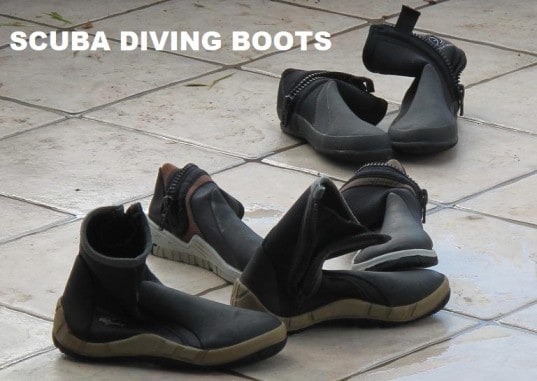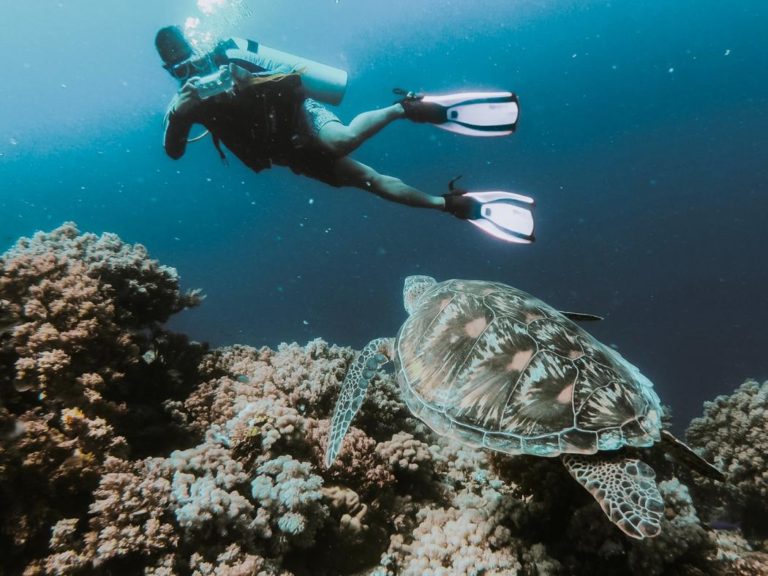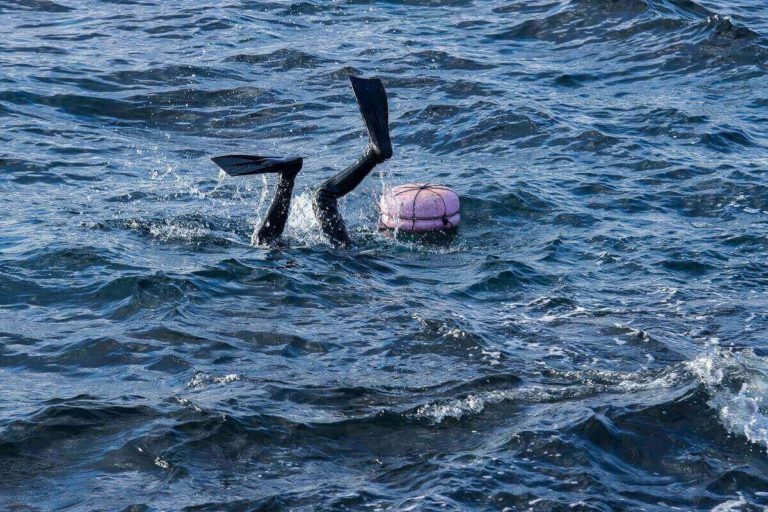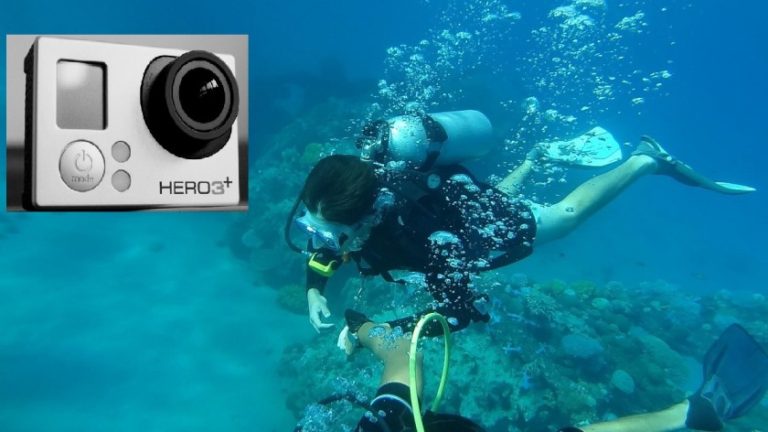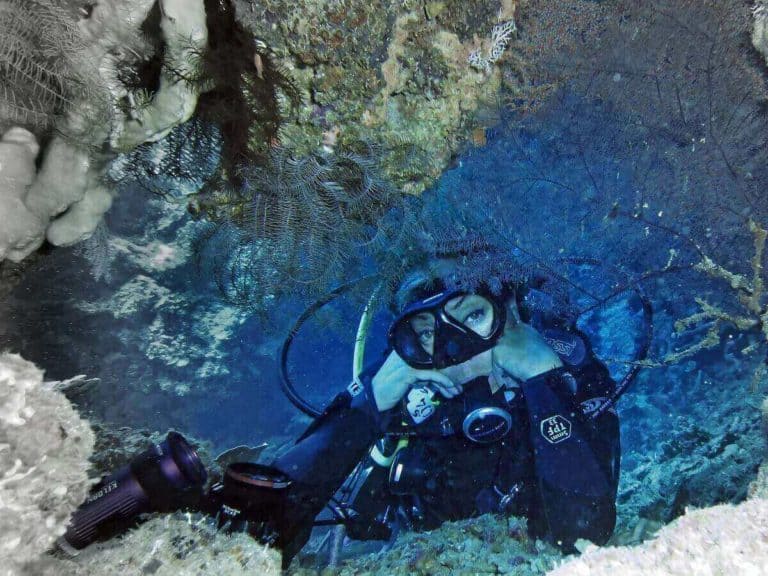Do You Wear Dive Boots with Fins?
Dive boots are necessary diving accessories, especially when diving in cold water, in sites with corals, and rocks, or when you have to hike down to a beach. Scuba divers with very small feet can also wear diving boots to help fit in the fins available. Dive boots help in keeping you warm and protecting your feet from injuries and bruises from corals, rocks, or other sharp objects in the water. With this in mind, one may wonder do you wear dive boots with fins.
Yes, you can wear scuba diving booties with fins. However, it’s important to pick the right size dive boot and the correct size fins. Picking a dive boot that is very loose will interfere with your kicking ability and possibly cause cramping of the foot muscles. Similarly picking a fin that doesn’t fit properly with the dive boot on will have the same effects on the diver affecting the quality of the dive.
Many divers with small or narrow feet have a hard time finding rental fins that have a snug fit. As a result, many prefer investing in their own gear to avoid inconveniences each time they go diving.
In this article, I went over the best fins for small feet. Just click on the link to read it here on my site.
In case you still can’t find fins that fit you perfectly, then this article is for you. With the help of diving booties, you can relax. The boots add some volume to the small or narrow feet allowing you to buy most fins available in dive shops.
In this article, we’ll look into diving booties, whether you can wear them with fins, things to consider when buying diving boots, which type of fins work well with diving boots, the best scuba boots with heels and so much more.
Keep reading to learn more!
New shoes…#diving #scubadiving pic.twitter.com/ygcxDg1IrI
— Andreas Scherbaum (@ascherbaum) June 30, 2018
Do You Need Booties for Scuba Diving?
You will need diving booties when scuba diving in cold water, wearing open heal fins, scuba diving in a site with lots of corals, if you have to walk down to the beach to access the dive site and if you have small feet.
Scuba diving while wearing the correct gear helps keep you warm. Whether diving in tropical water or in cold water, water draws heat away from the body 25 times faster than air. Therefore it’s important to wear protective diving gear that keeps the body well insulated and helps prevent hypothermia.
Diving booties are most preferred when diving in cold water. While diving in topical regions, divers can choose to dive with only the fins. If you tend to get very cold, diving socks are recommended for warmer waters.
The type of fin you are wearing will also determine whether you need booties or diving socks. Divers wearing full-foot fins don’t need booties or diving socks since the fins protect the diver’s feet and also help keep them warm.
On the other hand, divers wearing open-heel fins will require either diving booties or diving socks. The adjustable straps on the fins ensure there is enough room for the boot.
Mostly used in cold water diving, open heel fins leave the diver’s heel exposed which can cause heat loss. Diving boots and socks help in covering up the heel and also allow the fins to fit properly in case the diver has a small foot.
Diving boots are life savers when you have to trek down a sandy beach carrying all the diving gear. The extra padding on the boot heels helps release pressure from the weight of your equipment as well as protect you from injuries and bruises.
shoes for #drysuit #freediving #spearfishing #apnea #scubadiving #diving #scubagear #gear #scubadive pic.twitter.com/rPczP6wmAh
— D&D SNC NEOPRENE (@DeD_ITA) May 3, 2016
Types of Diving Boots
Scuba diving booties come in two types;
- soft sole booties
- hard sole booties
Both types use the same material to make the boot which is neoprene and nylon, similar to the type used in making wetsuits. The only difference is the nature of the heel.
Soft sole booties are soft as the name suggests and tend to be thinner. The sole is made using rubber. These can easily fold into themselves making them easier to package and travel with.
On the other hand, hard-heeled booties have a thicker rubber sole. These will keep your feet most protected especially when walking on sandy beaches. Hard-heeled booties can’t fold into themselves meaning you’ll need extra packing space when traveling.
Hard-heeled booties are perfect for diving in very cold water as they offer maximum insulation. These can range anywhere from 5 -7 mm in thickness. Don’t worry while the material used on the heel and the upper side are thick they are easy to put on and take off. The zippers provided make it easy to slide into them.
Soft-heeled booties are also effective in keeping the feet insulated but if you have to trek down to a beach, then you will most likely feel the pressure of stepping on the small rocks and pebbles.
Picking a bootie will depend on the diving environment and personal preference. If you don’t have to walk down a rocky beach, soft booties will work as well as hard-heeled ones.
READ MORE: Best Scuba Fins for Wide Feet
What To Look For In Scuba Boots
With this information in mind, it’s time to buy some scuba diving boots for your upcoming dive trip(s).
The main thing you should look for in scuba boots is a snug fit. The boots shouldn’t be too tight or too loose. The big toe should not press on the boot and your soles shouldn’t feel cramped at the back of the booties.
If the big toe presses to the boot then you are likely to have foot cramping and this is an indicator that it’s too small.
- Pick a boot that is easy to put on and take off.
- Ensure that the booties have a snug fit around the foot and the top of the boot lies perfectly onto your footbridge.
- No extra spaces should be around the top of the boot and your feet. These spaces allow a lot of water into the foot which can be very uncomfortable.
Since diving boots come in men’s size, women should pick a boot that is 1-2 sizes down from their normal shoe size. Take caution when shopping online to avoid buying a size too big or small.
Once you have the snug-fitting bootie either soft or hard-heeled, it’s time to pick the perfect size fins.
Tips to pick the perfect fin size
Keep in mind that the bootie will add a few millimeters to your foot so you can’t fit in fins as you would without a bootie or with a diving sock on.
It’s advisable to try on different sizes of open heel fins until you find the perfect match. Don’t settle for the first fin that feels right.
- The goal is to find a fin that fits snugly around the upper side of the foot (footbridge) and the sole of your diving booties should meet the sole platform of the fin. Meaning that the fin sole platform should either cover the boot heel or cover it partially.
- The heel on the boots shouldn’t be far out the fin. This way you can easily adjust the straps and kick without cramping your foot.
- In case the boot heel is far out, the diver will have trouble kicking resulting in foot cramping. The fin sole is likely to press on the foot causing snapping each time you kick causing more pain and cramping.
- In addition, if the sole platform is far apart from the boot heel you are likely to get tired very quickly from kicking.
- Similarly, if you can fit your finger around the footbridge and the fin, then the fin size is wrong. It shouldn’t be too tight that it presses the skin either for swift kicking.
- Look for fins with comfortable straps that won’t press too tightly onto your foot.
Best Scuba Boots with Heels
SCUBAPRO 6.5mm Heavy Duty Boot
The ScubaPro boot is designed for walking in tough or rough conditions, diving in cold water, and offering maximum support to your feet and toes.
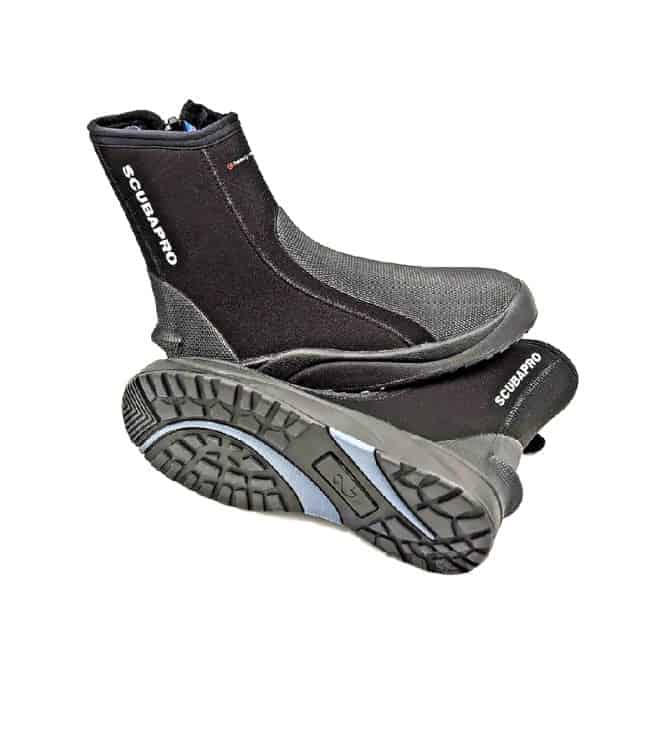
When carrying heavy diving equipment the feet are protected and you won’t get sore from all the downward pressure. The reinforced rubber sole ensures your back is protected too while carrying heavy gear.
Made using nylon and neoprene the boot is designed to last while keeping you warm and protected from foot injuries.
Comes with a zipper for easy slip-in and take-off and an additional Velcro fastening to ensure your feet remain protected. When hiking down to a beach don’t worry about the fastening on the boot in case you slide or fall.
The thick neoprene material keeps water out, with no uncomfortable situations of water flooding the booties during the dive.
A built-in fin stopper ensures the diver is comfortable and fins don’t slip off while diving.
They a very affordable and a great investment worth every penny.
Lastly, the boots can be used in other water sports such as fishing, kayaking, and many others.
Mares Dive Boot FLEXA DS 5mm
Boots from a reputable scuba diving brand. Mares is a widely known brand among scuba divers for their efficient diving gear such as these open-heel scuba fins, (perfect for pairing with booties), wetsuits, masks and so much more.
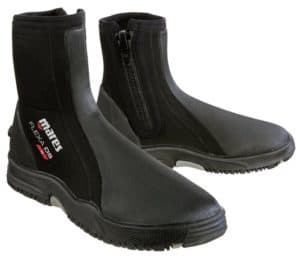
These boots are 5 mm thick making them perfect for scuba diving in cold water. They are also designed for walking on tough terrains and diving among corals. The thick neoprene and rubber sole protect the feet from cuts, bruises, and other injuries.
For easy slip-in and slip-off, zippers located on the sides of each boot allow easy access and comfort.
One unique feature to love in these boots is the DS drainage system. This prevents them from getting sucked up in the fin. In case a boot is sucked in while diving then this can result in leg muscle cramping as the diver tries to kick.
The boots have an in-built fin stopper at the back preventing the fins from slipping off.
They are very lightweight and have great value for money. If you are looking for an affordable dive boot option this is a winner.
Cressi Neoprene Adult Anti-Slip Sole Boots
Looking for soft-heeled booties, look no further.
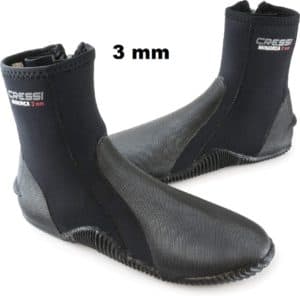
The Cressi 3 mm anti-slip boots are perfect for diving in cold water. If the dive site is easily accessible by boat then these will work perfectly since you don’t have to walk or hike to a rocky beach.
The boots are ideal for other water sports such as snorkeling, water rafting, kite surfing, and many more.
Made using nylon and neoprene, the boots offer utmost insulation keeping your feet warm. The soft yet strong rubber protects the feet from cuts and injuries while diving among corals or walking on a beach before and after the dive.
The sole is anti-slip meaning you don’t have to worry about falling while on the boat or on a slippery surface in your resort.
The boots have a fin stopper too to keep the fins intact throughout the dive.
Parting Words
We’ve looked at what to look for when buying diving boots. It’s important to ensure the boots fit perfectly with the diving fins for swift kicking and to prevent cramping.
We’ve also seen that diving booties are mostly worn with open heel fins and are ideal when diving in cold water, walking on the beach, and for divers with small or narrow feet.
Diving booties should never be worn with full fins since they must fit perfectly and offer needed protection to your feet. If you require extra insulation, then diving socks are a preferred option.
I hope this article answers your question on whether you can wear dive boots with fins and how to pick the correct dive boots.

